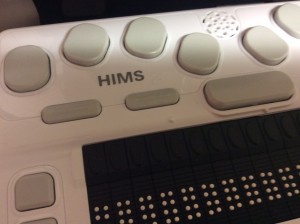Ever seen one of these? It’s an internet ready refreshable Braille note taker. Yes, a web browser in a portable Braille display.
Is your website truly cross platform?
You may of worked hard to ensure your site works across different screen sizes, from mobiles to large HD displays. Tested it works in all the latest browsers from Safari, Chrome, Firefox, Opera and Internet Explorer. This is all great but what about Braille devices?
What are and who uses Braille displays?
A Braille display or note taker like the U2Mini, are an electronic device that uses a matrix of pins that pop up in different patterns to create the tactile writing called Braille. Invented over two hundred years ago by Louis Braille in France. This is generally associated with the blind but is a life line to people with both sight and hearing loss. Devices like the U2Mini can be used independently and often have WIFI, Bluetooth connectivity with internet browsing built-in.
These devices generally don’t have any mouse pointer so interact with websites in much the same way as screen reader software does, via the keyboard. The other key point, is the display is only made up of a limited number of Braille characters all on a single line. The user will need to scroll through the information, only being able to read one small section at a time. A little like screen magnification software. Plus there are no indications of colour in Braille, so any reference to colours can not be used in Braille.
You may notice, the keyboard is not a conventional querty keyboard but instead a Braille keyboard. The device will manage the interfacing between the Braille keys and the expected ASCII keyboard input on your website. So you don’t need to know how to read or write Braille to support these devices.
How can we test for Braille devices
Don’t worry, you won’t need to rush out to buy one of these, for most it would be a very costly waste of time, especially if you don’t read and write in Braille.
However, there are things you can do, like follow best practice for device independence and progressive enhancement, don’t rely on colour alone to identify something and ensure you have suitable alternative text for non text items. Many of the WCAG2.0 POUR principles will still apply, so understanding these can only help you produce accessible web content.
If you want to go the extra mile you can always ask people who use Braille displays to give feedback on their experiences. There are many user groups and specialist accessibility auditors who use teams of people to perform user testing with all kinds of devices.
Have your say
- Ever wonder how people with sight and hearing loss can get equality through the internet?
- Ever wonder how blind people can communicate with deaf people?
- Ever seen a Braille display in use?
